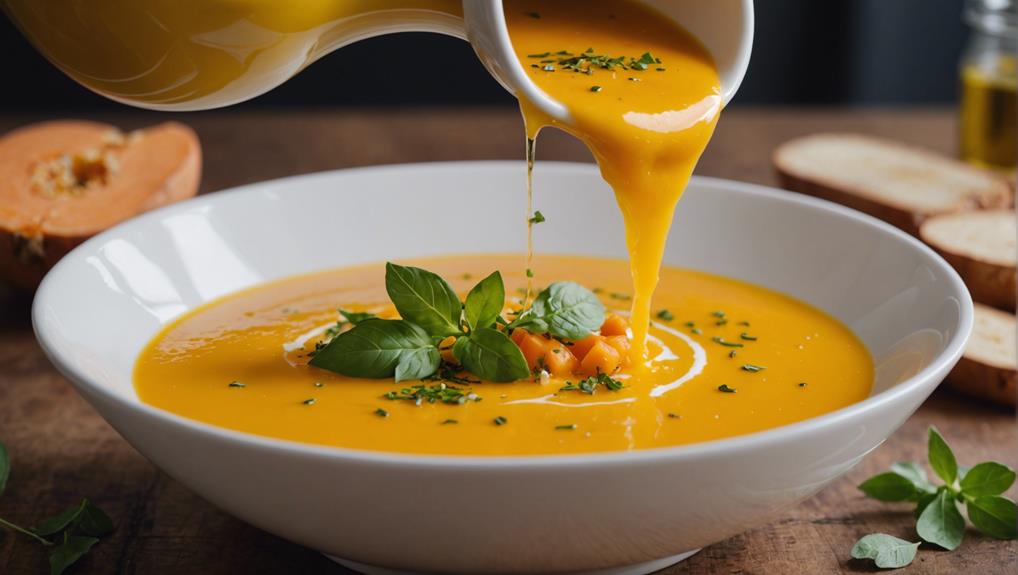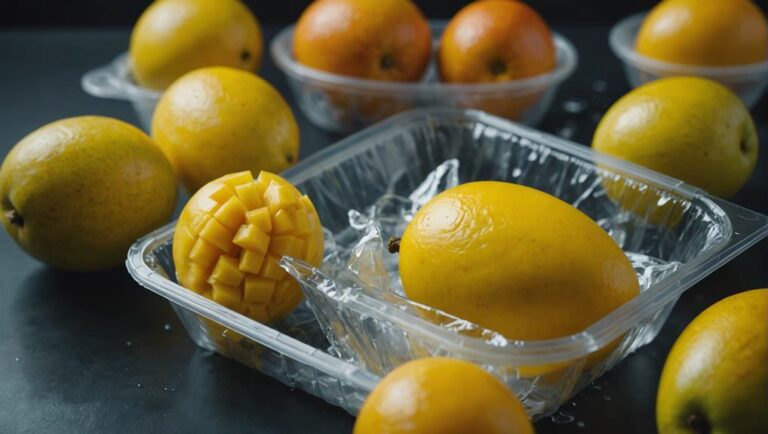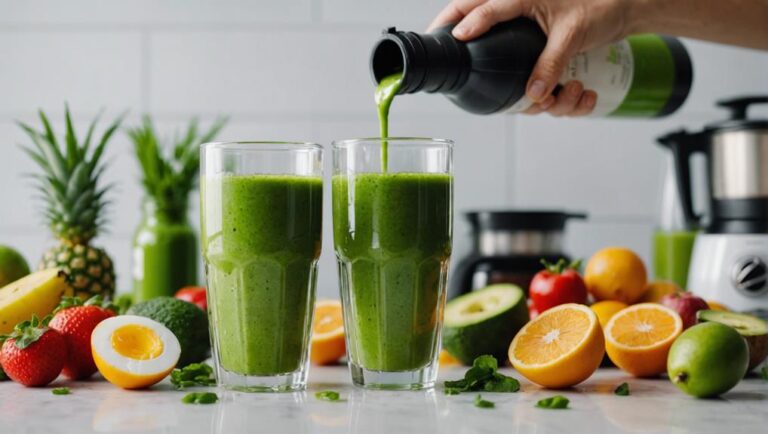Sous Vide Butternut Squash Soup
Indulge in the refined fusion of flavors and textures with sous vide butternut squash soup. Enhance traditional ingredients through precise cooking techniques for a luxurious dining experience. Benefit from consistent temperature control using the sous vide method, ensuring tender and vibrant butternut squash. Elevate your culinary skills by experimenting with variations such as added apples, spices like curry powder, and garnishes like crème fraiche. The velvety smooth texture and intensified flavors of this soup will mesmerize your taste buds and elevate your gastronomic journey to new heights.
What You Will Learn Here
- Sous vide involves vacuum-sealing butternut squash for precise cooking
- Cooking in a water bath at exact temperature ensures consistent results
- Retains vibrant color, texture, and nutrients for a visually appealing dish
- Anova Precision Cooker offers precise temperature control for perfect soup
- Ensures velvety smooth texture and optimal infusion of flavors
Soup's Evolution Over Time
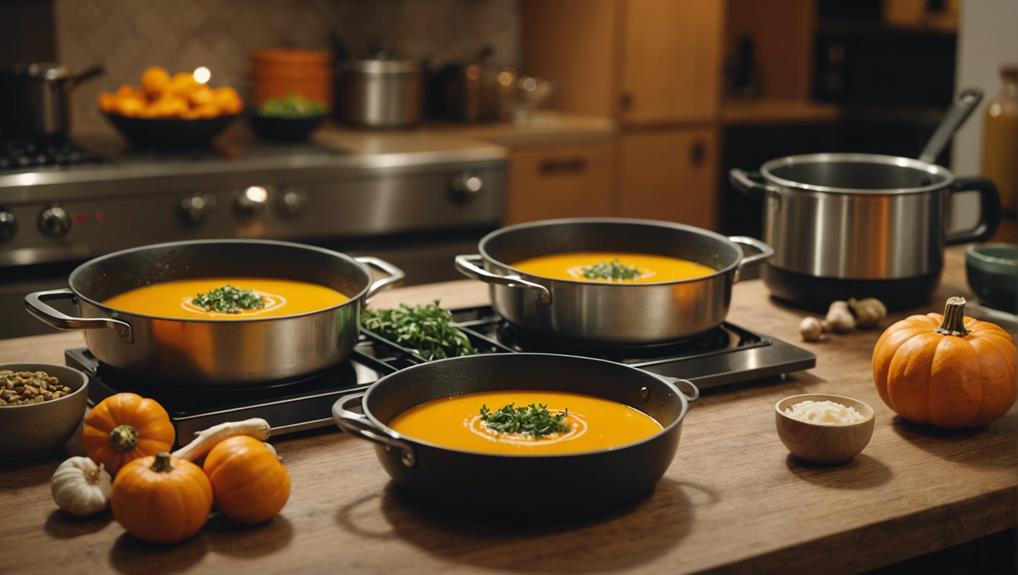
You'll notice that historical soup recipes have undergone significant transformations, with modern variations incorporating diverse ingredients like apples, carrots, and almonds. These ingredient innovations haven't only enhanced flavor but also boosted the nutritional value of butternut squash soup.
The evolution of soups over time reflects a harmonious blend of tradition and innovation, catering to a spectrum of culinary preferences.
Historical Soup Recipes
The evolution of soup recipes throughout history showcases a rich tapestry of culinary innovation and cultural influences. Historical soup recipes date back to ancient civilizations like the Greeks and Romans who used ingredients like grains, vegetables, and meat in their soups. The evolution continued through the Middle Ages, introducing more complex broths, stews, and potages. In the Renaissance period, soups became refined with exotic spices, herbs, and meats. The Industrial Revolution commercialized soup production, with companies like Campbell's introducing canned soups in the late 19th century. This historical journey highlights how soups have evolved from simple concoctions to elaborate dishes, incorporating a variety of ingredients and culinary techniques.
| Historical Period | Key Features |
|---|---|
| Ancient Civilizations | Grains, vegetables, and meat in soups |
| Middle Ages | Complex broths, stews, and potages |
| Renaissance | Refined soups with exotic spices and herbs |
| Industrial Revolution | Commercialization with canned soup production |
Modern Soup Variations
As soup recipes evolved from ancient civilizations to the present day, modern variations have embraced new ingredients and cooking techniques, such as sous vide, to redefine traditional flavors and elevate the soup experience.
Chefs today are experimenting with innovative methods like the water immersion technique to achieve precise cooking temperatures, resulting in perfectly cooked soups with enhanced flavors.
For instance, a velvety Butternut Squash Soup infused with the subtle sweetness of apples and the richness of a well-prepared stock showcases how traditional ingredients can be combined in new ways.
These modern soup variations cater to a wide range of palates, offering unique textures and flavor profiles that appeal to the ever-evolving culinary preferences of today's food enthusiasts.
Ingredient Innovations
Evolve your culinary repertoire by exploring the dynamic transformations in butternut squash soup through innovative ingredient combinations and techniques.
The traditional butternut squash soup has undergone a remarkable evolution with the addition of apples, carrots, and almonds, enriching both flavor and nutrients. By incorporating diverse herbs, spices, and seasonings, this classic soup has become a versatile and customizable dish, catering to various tastes.
Chefs and home cooks have elevated the presentation and taste of butternut squash soup with creative garnishes like crème fraiche, parmesan crisps, and cilantro.
The adaptation of modern cooking techniques such as sous vide has further enhanced this evolution, resulting in a nutrient-rich and delicious final product.
Embrace the adaptability of butternut squash soup and savor its delicious journey through time.
Key Soup Components
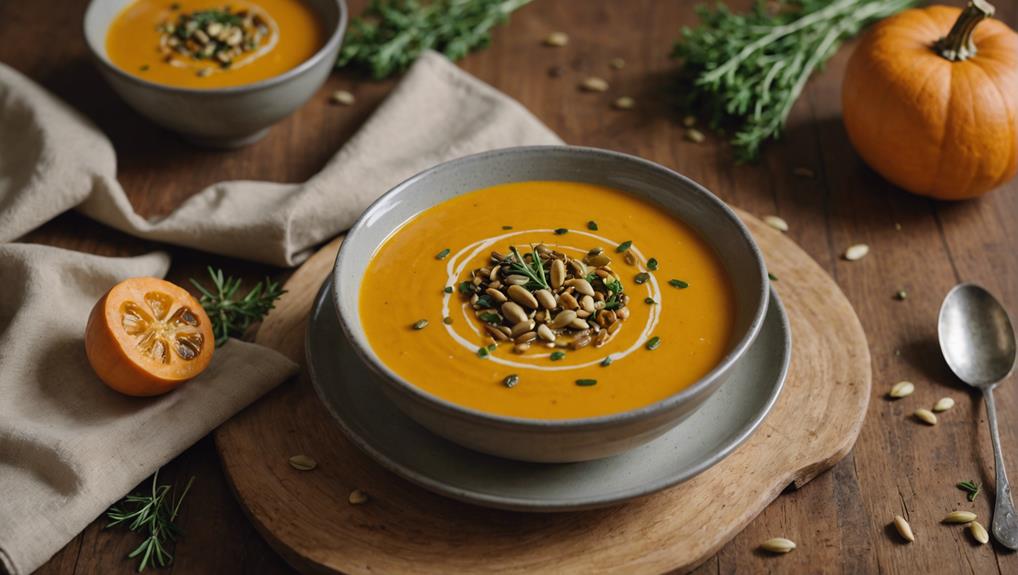
To create a harmonious blend of flavors in your sous vide butternut squash soup, carefully select and prepare the key components.
- Butternut Squash: The star ingredient, rich in flavor and nutrients, forms the base of your soup.
- Apple: Adds a hint of sweetness and a pleasant tartness to balance the flavors.
- Stock: Whether vegetable or chicken, a good quality stock enhances the depth of taste in your soup.
- Blender: An essential tool for achieving that velvety smooth texture, ensuring a luxurious finish to your dish.
Each component plays an essential role in the symphony of flavors that make up your butternut squash soup. The sous vide cooking method preserves the essence of these ingredients, allowing them to meld together harmoniously.
As you start on this culinary journey, remember that the choice of each element contributes to the final masterpiece that will warm both your body and soul. Enjoy the process of creating a nourishing and delightful soup that reflects your unique taste preferences.
Butternut Squash Soup Variations
When exploring variations of butternut squash soup, you can experiment with ingredients like apples, carrots, and onions to enhance the flavors.
Adding spices such as curry powder or cayenne pepper can provide a unique twist to your soup, infusing it with a delightful kick of heat.
For a creamy texture, consider incorporating ingredients like coconut milk or creme fraiche to elevate the richness of your butternut squash soup.
Sous Vide Butternut Squash Blend
For a delightful twist on traditional butternut squash soup, consider exploring various sous vide butternut squash blends that offer a spectrum of flavors and textures. When experimenting with sous vide butternut squash, you have the freedom to create unique combinations that elevate this classic soup.
Here are some exciting ideas to inspire your culinary creativity:
- Seal butternut squash with honey and cinnamon for a sweet and aromatic blend.
- Infuse the squash with thyme and garlic for a savory and herbaceous twist.
- Create a velvety texture by blending butternut squash with coconut milk and curry.
- Add a hint of warmth by combining roasted red peppers with the squash for a smoky flavor profile.
These blends allow you to savor the essence of butternut squash in innovative ways.
Sous Vide Butternut Squash Risotto
Experience the velvety richness of sous vide butternut squash risotto as it combines creamy arborio rice with the subtle sweetness of butternut squash, creating a luxurious dish perfect for cooler seasons.
- Creamy Texture: Sous vide method guarantees a rich and velvety texture.
- Customizable Flavors: Add herbs, cheeses, or proteins for diverse flavor profiles.
- Consistent Cooking: Sous vide assures even cooking, preventing under or overcooking.
- Luxurious Comfort: A comforting dish ideal for fall and winter meals.
Indulge in the exquisite flavors of butternut squash and the creamy goodness of risotto, elevated by the sous vide technique. Customize your dish to your liking and savor the comforting warmth of this luxurious meal.
Sous Vide Butternut Squash Risotto
To enhance the velvety richness of your butternut squash risotto, consider infusing it with aromatic herbs and savory Parmesan cheese during the sous vide cooking process.
- Elevate the flavors by adding a touch of nutmeg for a warm, earthy note.
- Experiment with different risotto rice varieties like Arborio or Carnaroli for unique textures.
- Try incorporating crispy pancetta or toasted pine nuts for contrasting textures.
- Finish your dish with a drizzle of truffle oil for a luxurious touch.
Sous Vide Butternut Squash Risotto offers a creamy and flavorful twist on a traditional favorite, providing a sophisticated and gourmet experience for your taste buds. Enjoy the precise control over temperatures and the infusion of rich flavors that this cooking method brings to this classic dish.
Sous Vide Technique Insights
When utilizing sous vide cooking, you engage in a precision cooking method that guarantees consistent temperature control. This technique is renowned for its ability to retain and enhance flavors in ingredients, resulting in a delicious end product.
The precise temperature control offered by sous vide cooking allows for a remarkable enhancement in flavor retention.
Precision Cooking Method
Using the precision cooking method of sous vide, you can effortlessly achieve consistent and tender results for your butternut squash soup every time. Sous vide involves vacuum-sealing butternut squash in a pouch and cooking it in a water bath at a precise temperature, such as 185°F (85°C). This technique guarantees that the vibrant color, texture, and nutrients of the squash are retained, enhancing the overall flavor of the soup.
Ideal for meal prep and batch cooking, sous vide helps you avoid the risk of overcooking, ensuring a perfectly cooked dish. Machines like the Anova Precision Cooker offer edge-to-edge perfection and ease of use for home cooks excited to explore this cooking method. Enjoy the freedom of consistently delicious butternut squash soup with sous vide precision.
Consistent Temperature Control
For achieving precise and consistent results in sous vide cooking, maintaining a steady temperature control is crucial. When cooking butternut squash soup sous vide, the water immersion method guarantees that the precise temperature control is maintained throughout the cooking process. By sealing the soup in a vacuum-sealed bag, you create an environment where flavors intensify, and nutrients are retained. The controlled temperature of 185°F (85°C) for the butternut squash soup recipe allows for a perfect infusion of flavors without the risk of overcooking. This technique guarantees that every spoonful of soup delivers a velvety smooth texture and a burst of butternut squash goodness. See the table below for a visual understanding of how precise temperature control impacts sous vide cooking:
| Temperature Control | Water Immersion | Vacuum-Sealed Bag |
|---|---|---|
| Consistent Results | Yes | Yes |
| Flavor Retention | High | High |
| Texture Preservation | Excellent | Excellent |
Enhanced Flavor Retention
To further enhance the depth of flavors in your sous vide butternut squash soup, consider how the prolonged cooking time allows for a harmonious melding of ingredients, resulting in a rich and complex taste profile.
The controlled temperature of 185°F (85°C) in sous vide cooking guarantees that the vibrant colors of butternut squash and apple are retained, enhancing the visual appeal of the soup.
This method seals in the flavors of the ingredients, creating a velvety smooth consistency while allowing the natural sweetness of butternut squash and apple to shine through.
The slow cooking process of sous vide also enables the herbs and spices to infuse fully, enhancing the overall taste of the soup.
Embrace the controlled temperature of sous vide for flavor retention and a delightful dining experience.
Final Thoughts
In conclusion, considering the ease of preparation and customizable nature of this sous vide butternut squash soup, it stands as a versatile and delightful addition to any autumn menu. The fusion of butternut squash, apple, onion, garlic, and a blend of herbs and spices creates a symphony of flavors that is both comforting and nutritious. The option to tailor the soup by adding cream for richness or a splash of vinegar for a tangy twist allows for a personalized culinary experience. Whether served as a starter or a main dish, this soup promises to impress even the most discerning palates.
| Pros | Cons |
|---|---|
| Easy and quick preparation | Requires sous vide equipment |
| Customizable to individual tastes | Initial prep time for ingredients |
| Healthy and seasonal ingredients | May need additional seasoning |
Frequently Asked Questions
Does Butternut Squash Need to Be Peeled for Soup?
Yes, butternut squash needs to be peeled for soup. It guarantees a smooth texture, removes tough skin, and aids in blending flavors. Peeling enhances taste, appearance, and allows for better incorporation of ingredients, leading to a more delicious final dish.
Why Is My Butternut Squash Soup Gritty?
If your butternut squash soup is gritty, it might be due to insufficient blending, leaving fibers in the mix. Try using a high-powered blender or immersion blender for a smoother consistency. Straining post-blending can help too.
Is Butternut Squash Soup Good for Blood Pressure?
Butternut squash soup is beneficial for blood pressure due to its high potassium and fiber content. Incorporating it into your diet alongside fruits and vegetables can support heart health, improve blood vessel function, and help regulate blood pressure levels effectively.
Is Butternut Squash Soup Healthy?
Yes, butternut squash soup is healthy. It's packed with vitamins, fiber, and antioxidants that can boost your immune system, eye health, and digestion. Plus, it's low in calories and fat, making it a great choice for weight management.
Conclusion
As you savor each spoonful of sous vide butternut squash soup, you experience a harmonious blend of flavors that have been meticulously crafted through time and technique.
The evolution of soup, the key components, and the variations of butternut squash soup all contribute to the depth and complexity of this dish.
The sous vide technique elevates the flavors even further, resulting in a velvety smooth texture that's simply unparalleled.
Indulge in this culinary masterpiece and savor every moment.
